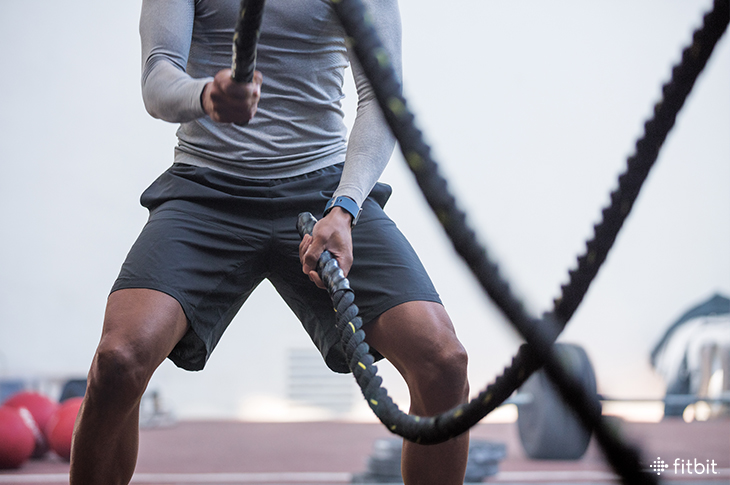
It used to be that exercise equipment was pretty self-explanatory: You never needed a lesson before picking up a jump rope or dumbbell. But look around a gym today and you’ll see all kinds of weird looking contraptions that you probably have no idea how to use. While it’s natural to be confused or intimidated by the unfamiliar, some of these new pieces of equipment can make it easier (and more fun!) to get fit. You just need a little insight into how to use them first. Below, exercise equipment every gym jock should know.
Exercise equipment: Battle ropes
They look like normal ropes, but pick one up (most weigh around 25 pounds) and give it a whip —you’ll quickly realize why they’ve become a popular fitness tool. “Battle ropes are great at strengthening your upper body,” says Seamus Dooley, the Tier X Manager at Equinox Highland Park in Texas. “Plus, moving a rope as fast as you can for 30 seconds will get your heart rate way up, so it adds a cardio component to your workout without you needing to hop on a treadmill or bike.”
Give it a try: Stand with your core engaged, hinged slightly forward at your hips. Hold a battle rope in each hand and move them explosively up and down, alternating between your right and left arm as if you’re playing drums for 30 seconds. Targets: biceps, triceps, abdominals, obliques, lats, shoulders
Exercise equipment: Monster truck tire
This humongous tire weighs at least 100 pounds and is used almost exclusively for a move called a tire flip—CrossFitters love it. “These truck tires are a fun, different way to strength train,” says Dooley. “It’s so rewarding to move something really big—it gives you a huge sense of accomplishment.”
Give it a try: The tire flip is really two moves in one. First, you’re going to mimic a deadlift with the tire. Stand in front of it, squat down, and deadlift it up until you’re standing. Then move on to the second part, where you push the tire away from your chest until it falls forward. If it’s too heavy to do alone, team up with a friend and flip the tire together. Aim to do 3 flips in a row. Targets: quads, hamstring, glutes, core, biceps, triceps, chest
Exercise equipment: Kettlebell
It looks kind of like a ball of lead with a handle, and that’s exactly what it is. But don’t let its simple design fool you: You can actually use it in tons of different ways. “Get a high-intensity workout in by doing kettlebell swings or use it to strengthen specific body parts by doing overhead presses or back rows with it,” says Dooley.
Give it a try: The most common move is a Russian kettlebell swing. Stand holding a kettlebell by the handle with both hands. Hinge forward at your hips, keeping your spine completely straight. Swing the bell between your legs, then explosively drive your hips forward, squeezing your glutes, and driving the bell up. It should top out at around chest level (don’t pull the bell with your arms, let momentum carry it). Allow the bell to fall back down between your legs. Repeat 10 times. Targets: core, glutes, hamstrings, lats, traps
Exercise equipment: Pilates ring
This flexible ring (sometimes called a magic circle) is often used in Pilates classes—it lets you work your arms or legs while doing core work. For example, squeeze it between your upper thighs while doing crunches or push into it with your hands while doing leg lifts.
Give it a try: Lie on your back with knees bent, feet flat on the floor. Place the ring in between your inner thighs and gently squeeze it to keep it in place. Engage your glutes and lift your pelvis up off the ground until you’re in a bridge position (your body should be in a straight line from knees to your chest). Squeeze the ring 10 times, then lower back down to start. Targets: glutes, quads, inner thighs
Exercise equipment: ViPR
This is a heavy cylinder, about the size of a foam roller, with multiple handles. It comes in lots of different weights and allows you to get a little creative with your strength training. “The ViPR lets you move a weight away from your body,” says Dooley. “When you do that, your center of balance shifts, so you have to engage your core to stay stable.”
Give it a try: Stand tall, holding the ViPR by its handles in front of your chest. Lunge to the side with your right leg, keeping your toes in line with each other and resting your weight on your right leg. Once there, push the ViPR out at chest level, extending your arms all the way as if you’re doing a bench press. Bring the ViPR back into your chest, push off with your right leg, and return to start. Repeat 10 times, then switch legs. Targets: shoulders, back, biceps, core, glutes, quads, hamstrings.
This information is for educational purposes only and is not intended as a substitute for medical diagnosis or treatment. You should not use this information to diagnose or treat a health problem or condition. Always check with your doctor before changing your diet, altering your sleep habits, taking supplements, or starting a new fitness routine.

Great article. I actually attend HIIT sessions at a local CrossFit box and we actually use a couple of the pieces equipment you discuss here in these. The ones we use are the Battle Rope and the Kettlebell. I’ve only been going about a month but already am starting to see and feel the difference. In the beginning I was okay but couldn’t lift much or run far. Now I am starting to move forward and am now beginning to use much heavier kettlebells.